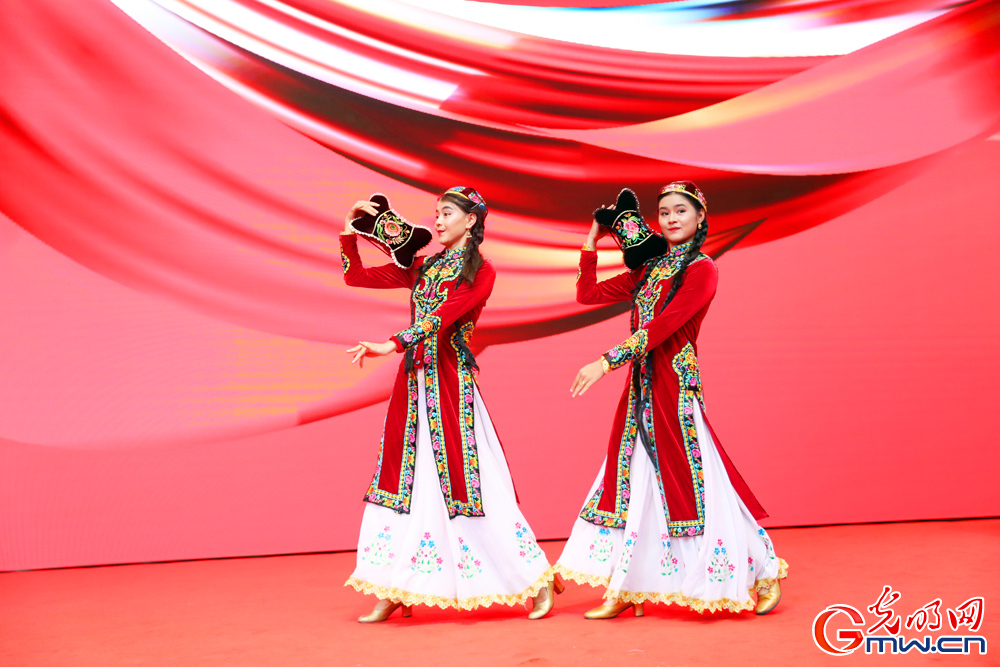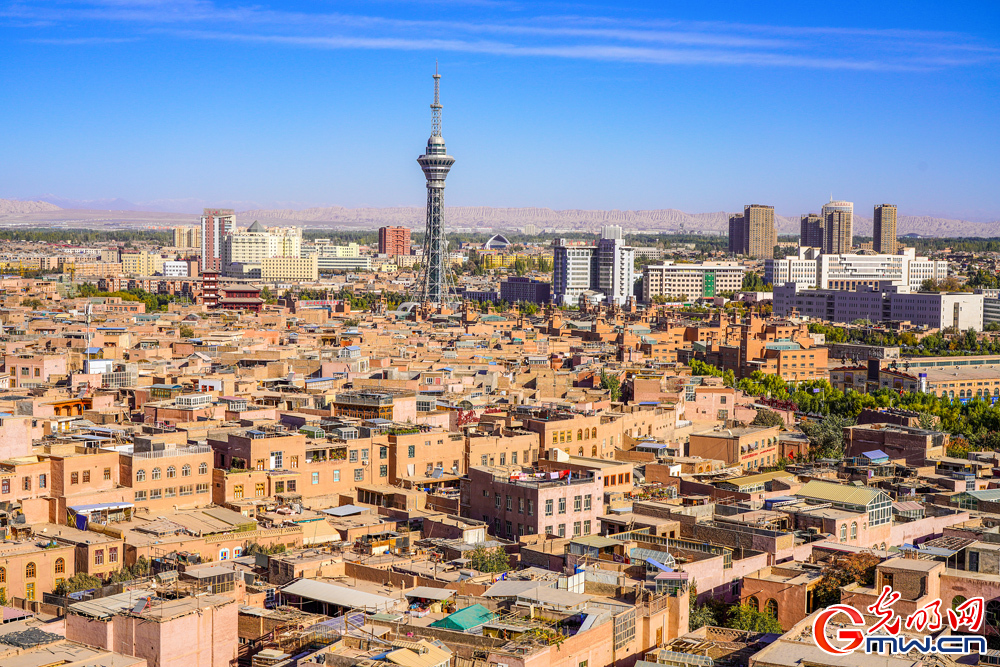

V
The founding of New China has made equality for all people and all ethnic groups in Xinjiang a reality. Under the leadership of the CPC in the new era, a beautiful chapter of Xinjiang featuring equality is being written. Xinjiang is the common home of all ethnic groups, and the beauty of Xinjiang is created by the people of all ethnic groups together. Equality is a pillar underlying the mansion of vitality in Xinjiang today.

Two dancers perform at anintangible cultural heritage exhibition in Hami, northwest China's Xinjiang Uygur Autonomous region, Aug. 2, 2022. (Photo/ Guangming Picture)
It is humanity’s great aspiration that all people are born equal. From “The Book of Rites”, which states that “the way of the world is public”, to Sun Yat-sen’s ideal of “the world is for everyone”, the simple idea of equality for all has been around for thousands of years.
It is an obvious fact that the people of Xinjiang have been suffering from harsh natural conditions and the threats from imperialist powers, and equality for all was once an unattainable luxury. In New China, the basic principles of ethnic equality, ethnic unity and the common prosperity have been adopted as the basis for solving ethnic problems and handling ethnic relations, and the system of regional ethnic autonomy has been implemented.
During our trip to Xinjiang, the autonomous region held its 76th special news conference, which comprehensively introduced that since the 18th CPC National Congress, Xinjiang has resolutely implemented the Party’s strategy in the new era, adhered to the people-centered development concept, and focused on solving problems that people are most directly concerned about, and that the people of all ethnic groups have significantly enhanced their sense of gain, happiness and security.
We traveled from the south to the north of Xinjiang, saw people wearing big and confident smiles, and felt dearly that the peaceful social atmosphere and the ethnic relations are like pomegranate seeds clinging together. Isn’t this the best illustration of equality? The following stories, among many, offer a glimpse into the picture of China’s ethnic equality policy in Xinjiang.
Story 1: 60-year-old retiree Aziguri Abula is a member of the Starlight Choir in the Guyuan Community, Tianshan District, Urumqi. Her husband died 10 years ago, leaving three children behind. The choir is a large family providing her with warmth and care. The choir has members from six ethnic groups, who sing and dance together, and are as intimate as a family. Not long ago, CPC General Secretary Xi Jinping inspected the community, and Aziguri and her sisters shouted together, “Hello, General Secretary!” Aziguri said, “I did not realize I broke in tears, and they were tears of joy and inspiration, and I’d cry whenever I think of the scene. There are more than 4,600 people in our community, each one is a pomegranate seed, and we are all holding together tightly. I will continue singing the song of happiness here with my sisters”.
Story 2: Nurman Guli Ruzemeti was born in late 1980s. Her father kept a 50-year-long friendship with a Han Chinese brother in Guangzhou, and this left a profound impact on Nurman Guli. She first studied at a high school in Shanghai, then went to Xi’an Shiyou University. After graduation, she returned to her hometown of Hotan to work in the community in Nurbagh. Her success is the result of ethnic equality. In 2016, when her daughter was less than two years old and her son less than 8 months old, she came to Tushala Township as a resident official, making greater contributions to ethnic unity. In 2019, she returned to her community and became its director, continuing her service for people of all ethnicities. “All family members of ours are Party members, and I will dedicate the rest of my life to the great cause of ethnic solidarity”, she said.
Story 3: 33-year-old Nur Nisha Alif is the youngest doctoral supervisor at Xinjiang Medical University. At 14, she entered the a high school in Wuxi, and has been studying outside of Xinjiang ever since. In 2019, after graduating from Zhejiang University with a PhD, she chose to return to Xinjiang despite many high-paying job offers. Now she serves as director of the Institute of Biomedical Engineering at Xinjiang Medical University. She always says that the Party’s ethnic policy is like sunshine and rain, and she is just one of the countless beneficiaries. She was the first person to have brought biomedical optics to Xinjiang. She said that “Xinjiang today offers equal opportunities to all those who work hard, and I will live up to the expectations of the Party and the people by fulfilling my mission”.
Story 4: Hao Xiangli, secretary of the CPC branch of Jianggs Village, Yumin County, Tacheng Prefecture, was born in the 1980s. She has been working on the post for three years, supported 39 rural revitalization projects, and built a special rural experience park for Generation Y, transforming the village into a famous tourist spot. The locals give her very high ratings, and that’s why she was elected as a representative to the upcoming 20th CPC National Congress. “Party building is a powerful means to achieve the aspirations of all ethnic groups. We ought to better develop our economy so as to bring equal opportunities to all”, she said.
Story 5: In Laika Township, Hotan County, the 7-year-old Uyghur boy whose broken arm was replanted became a household story. The boy accidentally stuck his right hand into the tractor’s pulley while playing, and most of his arm was ripped off. The window for replanting was only 6-8 hours, a ground-air transport relay across 1,400 km was launched as the boy’s life was at stake. An airplane taxied back to the passenger bridge, re-opened its hatch, and passengers aboard offered their seats, and the flight crew offered their full support and careful care along the way; traffic police in Hotan and Urumqi went all out escorting the ambulance to the hospital; Doctors stayed up all night long, and connected the brachial artery successfully, bringing a little boy back to life ...... this thrilling relay of love shows how every life in Xinjiang is cherished with care and compassion.
As we write this, we can’t help but think of the famous speech “I Have a Dream” by Martin Luther King, the leader of the black civil rights movement in the US.
Sadly for him, some 60 years later, his dream remains nothing but a dream. The desert of justice and oppression has not yet turned into an oasis, and out of the mountain of despair, there isn’t the stone of hope; freedom didn’t ring from the mighty mountains, and there is still a long way to go to achieve equality, fairness and justice for all.
Two years ago, George Floyd, a black man, was brutally killed by a white police officer on the street, blacks across the US took to the street, shouting “Black Lives Matter”. But white police brutality has not ended, George Floyds still “can’t breathe”.
Ethnic minorities, and Asians in particular, have increasingly been discriminated against and brutally attacked. There was a 361% jump in hate crimes against Asians in New York City alone in 2021 compared to 2020, and the pain of being a “perpetual alien” is shared by many, if not all Asian Americans. From public education to access to justice, people of color in the US have been systematically oppressed. In some states, non-white students receive about 60 percent less financial aid than white students; statistically, blacks and Latinos are, respectively, nearly 6 and 3.1 times more likely to be incarcerated than whites.
Minority ethnic groups in the US are systematically discriminated against during the Covid-19 pandemic, but mainstream American society turns a blind eye to their sufferings. In March 2020, when asked about “the wealthy gets prioritized in PCR test but the ordinary people have to stand in long lines and may still not get their chance”, Trump replied, “Maybe that’s life”.
White supremacy and racism are in the genes of American culture. And a country like this is always judging other countries.
The Liuxing Street in Yining City is a multi-ethnic neighborhood. When we arrived there, the sun was setting in the Yili River valley, but the lights on the street were already on, tourists roamed from the Russian-style gardens, the Uygur family courtyards and the Kazakh tent restaurants in beautiful ethnic music, and the aroma of daleba bread and roasted lamb permeated the block. In the courtyard where the Galsang flowers were in full bloom, people of all ages dressed in ethnic costumes sang and danced with the tourists in jubilation. You could feel no difference of race or age, and there were only songs, dances and joys.
Our reporters have only seen the tip of the iceberg of ethnic unity, people of different ethnicities are as close as brothers and sisters. In Tacheng, some families have several, even a dozen ethnic identities. If you ask “To which nationality do you belong?” People in Tacheng will proudly tell you, “Chinese nationality!”

Photo taken shows the scenery of the ancient city of Kashgar, northwest China's Xinjiang Uygur Autonomous Region. (Photo/ Guangming Picture)
Flying from Kashgar to Beijing, we had a panoramic view of Xinjiang from the airplane. When we waved goodbye to Xinjiang, we couldn’t help thinking of the household song “Lift Your Headscarf”.
Didn’t Xinjiang lift her headscarf and show us what she really looks like through this trip?
Yes, this is how Xinjiang really looks like!
(The Guangming Daily Research Team is composed of reporters Wang Huimin, Zhao Jianguo, Guo Lin, Bo Jieping, Li Hui, Shang Jie, Zhao Minghao, Wang Yizhao, Lin Ziyou, Bai Xuelei, Wand Jin, Zhong Chao, Liu Jiangwei, Liu Lu, and GMW.cn reporters Liu Jiaming and Zhang Andi)
点击右上角![]() 微信好友
微信好友
 朋友圈
朋友圈

请使用浏览器分享功能进行分享
